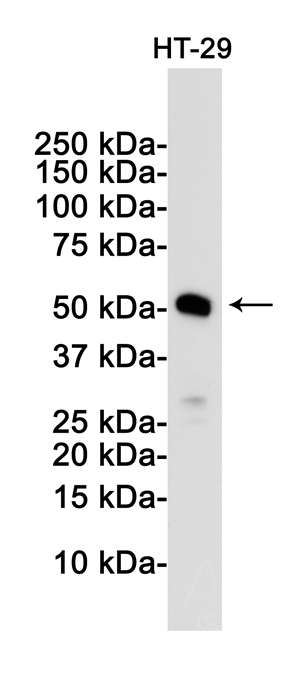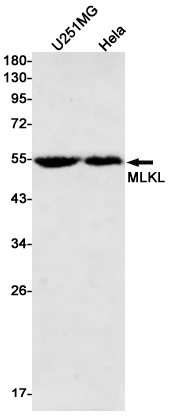

| WB | 1/500-1/1000 | Human,Mouse,Rat |
| IF | 咨询技术 | Human,Mouse,Rat |
| IHC | 咨询技术 | Human,Mouse,Rat |
| ICC | 技术咨询 | Human,Mouse,Rat |
| FCM | 咨询技术 | Human,Mouse,Rat |
| Elisa | 咨询技术 | Human,Mouse,Rat |
| Aliases | MLKL |
| Entrez GeneID | 197259 |
| WB Predicted band size | Calculated MW: 54 kDa; Observed MW: 54 kDa |
| Host/Isotype | Rabbit IgG |
| Antibody Type | Primary antibody |
| Storage | Store at 4°C short term. Aliquot and store at -20°C long term. Avoid freeze/thaw cycles. |
| Species Reactivity | Human |
| Immunogen | Recombinant protein of human MLKL |
| Formulation | Purified antibody in TBS with 0.05% sodium azide,0.05%BSA and 50% glycerol. |
+ +
以下是关于MLKL抗体的3篇关键文献概览:
---
1. **文献名称**:*Mixed lineage kinase domain-like protein mediates necrosis signaling downstream of RIP3 kinase*
**作者**:Sun, L. et al.
**摘要**:该研究首次将MLKL鉴定为坏死性凋亡(necroptosis)的关键执行蛋白,并开发了特异性抗体验证其被RIP3磷酸化后的激活状态,证明MLKL是坏死性凋亡信号通路的下游效应分子。
---
2. **文献名称**:*The pseudokinase MLKL mediates necroptosis via a molecular switch mechanism*
**作者**:Murphy, J.M. et al.
**摘要**:通过结构生物学和生物化学手段揭示MLKL的构象变化驱动坏死性凋亡,研究中利用MLKL抗体定位其构象变化,证明其通过形成寡聚体破坏细胞膜完整性。
---
3. **文献名称**:*Activation of the pseudokinase MLKL unleashes the four-helix bundle domain to induce membrane localization and necroptotic cell death*
**作者**:Hildebrand, J.M. et al.
**摘要**:研究利用MLKL特异性抗体追踪其亚细胞定位,发现MLKL激活后四螺旋束结构域暴露并靶向细胞膜,导致细胞破裂,为抗体在动态检测MLKL功能中的应用提供了范例。
---
**可选扩展**:
4. **文献名称**:*Necroptosis suppresses inflammation via termination of TNF- or LPS-induced cytokine and chemokine production*
**作者**:Petrie, E.J. et al.
**摘要**:通过MLKL抗体阻断实验,揭示坏死性凋亡通过终止促炎因子分泌调控炎症反应,为靶向MLKL的抗体在免疫疾病中的潜在治疗价值提供依据。
---
**备注**:上述研究均依赖MLKL特异性抗体进行机制验证,涵盖功能研究(如磷酸化检测、亚细胞定位)及治疗应用探索。
MLKL (Mixed Lineage Kinase Domain-Like) antibody is a critical tool in studying necroptosis, a programmed form of inflammatory cell death distinct from apoptosis. MLKL, a pseudokinase protein, acts as the terminal executor of necroptosis. Upon activation by receptor-interacting protein kinase 3 (RIPK3) via phosphorylation, MLKL undergoes oligomerization and translocates to the plasma membrane, disrupting membrane integrity and causing cell death. This pathway is implicated in various pathological conditions, including inflammatory diseases, neurodegenerative disorders, and cancer.
MLKL antibodies are widely used to detect MLKL expression, phosphorylation status, and subcellular localization in experimental models. They enable researchers to investigate necroptosis mechanisms through techniques like Western blotting, immunohistochemistry, and immunofluorescence. Specific antibodies targeting phosphorylated MLKL (e.g., at Ser358/Thr357 in humans) are particularly valuable for identifying active necroptosis signaling.
The development of MLKL antibodies has advanced understanding of cell death regulation and its therapeutic potential. Dysregulated necroptosis is linked to conditions such as ischemia-reperfusion injury, sepsis, and autoimmune diseases, making MLKL a promising biomarker and drug target. However, antibody specificity remains a consideration, as cross-reactivity with other kinases or phosphorylation states may occur. Validated MLKL antibodies are essential for reliable research outcomes in both basic and translational studies.
×